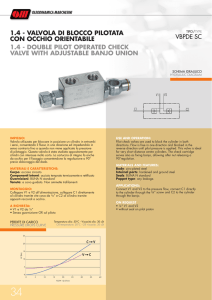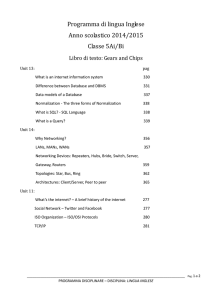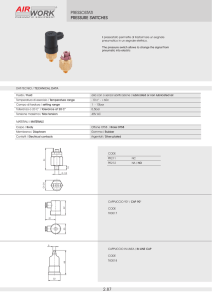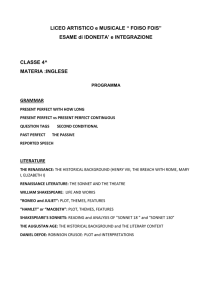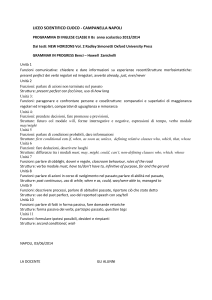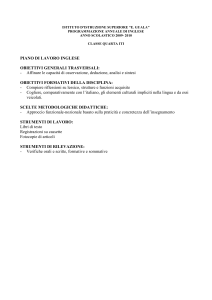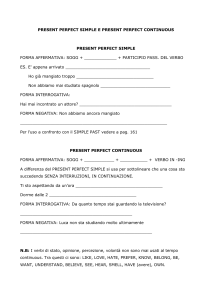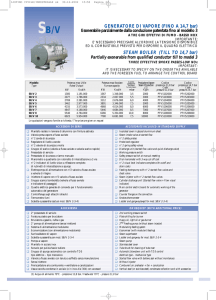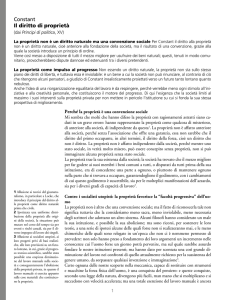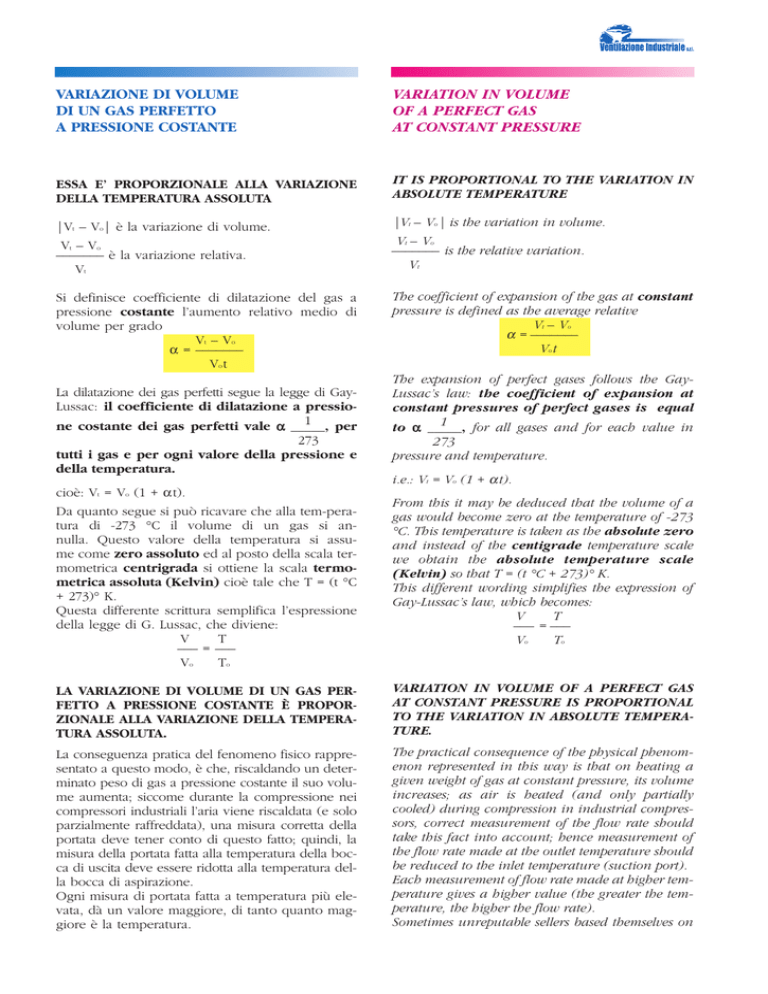
VARIAZIONE DI VOLUME
DI UN GAS PERFETTO
A PRESSIONE COSTANTE
VARIATION IN VOLUME
OF A PERFECT GAS
AT CONSTANT PRESSURE
ESSA E’ PROPORZIONALE ALLA VARIAZIONE
DELLA TEMPERATURA ASSOLUTA
IT IS PROPORTIONAL TO THE VARIATION IN
ABSOLUTE TEMPERATURE
|Vt – Vo| è la variazione di volume.
|Vt – Vo| is the variation in volume.
Vt – Vo
––––––– è la variazione relativa.
Vt
Vt – Vo
––––––– is the relative variation.
Vt
Si definisce coefficiente di dilatazione del gas a
pressione costante l’aumento relativo medio di
volume per grado
Vt – Vo
α = –––––––
Vo t
The coefficient of expansion of the gas at constant
pressure is defined as the average relative
Vt – Vo
α = –––––––
Vo t
La dilatazione dei gas perfetti segue la legge di GayLussac: il coefficiente di dilatazione a pressio1
ne costante dei gas perfetti vale α _____,
per
The expansion of perfect gases follows the GayLussac’s law: the coefficient of expansion at
constant pressures of perfect gases is equal
1
to α _____,
for all gases and for each value in
273
tutti i gas e per ogni valore della pressione e
della temperatura.
273
pressure and temperature.
cioè: Vt = Vo (1 + αt).
Da quanto segue si può ricavare che alla tem-peratura di -273 °C il volume di un gas si annulla. Questo valore della temperatura si assume come zero assoluto ed al posto della scala termometrica centrigrada si ottiene la scala termometrica assoluta (Kelvin) cioè tale che T = (t °C
+ 273)° K.
Questa differente scrittura semplifica l’espressione
della legge di G. Lussac, che diviene:
V
T
––– = –––
Vo
To
i.e.: Vt = Vo (1 + α t).
From this it may be deduced that the volume of a
gas would become zero at the temperature of -273
°C. This temperature is taken as the absolute zero
and instead of the centigrade temperature scale
we obtain the absolute temperature scale
(Kelvin) so that T = (t °C + 273)° K.
This different wording simplifies the expression of
Gay-Lussac’s law, which becomes:
V
T
––– = –––
Vo
To
LA VARIAZIONE DI VOLUME DI UN GAS PERFETTO A PRESSIONE COSTANTE È PROPORZIONALE ALLA VARIAZIONE DELLA TEMPERATURA ASSOLUTA.
VARIATION IN VOLUME OF A PERFECT GAS
AT CONSTANT PRESSURE IS PROPORTIONAL
TO THE VARIATION IN ABSOLUTE TEMPERATURE.
La conseguenza pratica del fenomeno fisico rappresentato a questo modo, è che, riscaldando un determinato peso di gas a pressione costante il suo volume aumenta; siccome durante la compressione nei
compressori industriali l’aria viene riscaldata (e solo
parzialmente raffreddata), una misura corretta della
portata deve tener conto di questo fatto; quindi, la
misura della portata fatta alla temperatura della bocca di uscita deve essere ridotta alla temperatura della bocca di aspirazione.
Ogni misura di portata fatta a temperatura più elevata, dà un valore maggiore, di tanto quanto maggiore è la temperatura.
The practical consequence of the physical phenomenon represented in this way is that on heating a
given weight of gas at constant pressure, its volume
increases; as air is heated (and only partially
cooled) during compression in industrial compressors, correct measurement of the flow rate should
take this fact into account; hence measurement of
the flow rate made at the outlet temperature should
be reduced to the inlet temperature (suction port).
Each measurement of flow rate made at higher temperature gives a higher value (the greater the temperature, the higher the flow rate).
Sometimes unreputable sellers based themselves on
Su questo fenomeno a volte venditori poco corretti si basano per dichiarare portate maggiori di quelle effettive.
Una tabella permette, dalla conoscenza delle temperature di aspirazione e di mandata, di effettuare
facilmente la correzione.
this phenomenon to declare flow rates greater than
the actual ones.
By knowing the inlet and outlet temperature the
correction can be easily made via a table.
t
v
t
v
t
v
t
v
0
10
15
16
18
20
25
1
1.036
1.055
1.058
1.066
1.073
1.091
30
35
40
45
50
60
70
1.110
1.128
1.146
1.165
1.183
1.220
1.256
80
90
100
110
120
130
140
1.293
1.329
1.366
1.403
1.439
1.476
1.513
150
160
170
180
190
200
1.549
1.586
1.623
1.659
1.695
1.733
Un esempio pratico di questo fenomeno è dato dal
fatto, noto fin dall’infanzia, che se si porta una palla di gomma floscia vicino ad una sorgente di calore, l’involucro si tende. Riportato nell’ambiente poi,
purtroppo, si sgonfia nuovamente.
A practical example of this phenomenon is given by
the fact that (as we know from our childhood days) if
we bring a soft rubber ball close to a source of heat,
its shell is stretched. If it is returned to the environment, unfortunately it is deflated once more.
T1 = 273 + t1°C
T2 = 273 + t2 °C
273 + t2
T2
V2 = V1 · ––––––– = V1 ––
273 + t1
T1
P2 = P1
Anche per l’aria uscente da un compressore a temperatura elevata succede la stessa cosa. Una volta
portata all’utilizzazione, se detta utilizzazione non
è nelle immediate vicinanze del compressore, l’aria
raggiunge la temperatura ambiente e... diminuisce.
Likewise the same thing happens to the air leaving
a compressor at high temperature. After moving to
the point of use, if the latter is not in the immediate
vicinity of the compressor, the air reaches ambient
temperature and... decreases.

